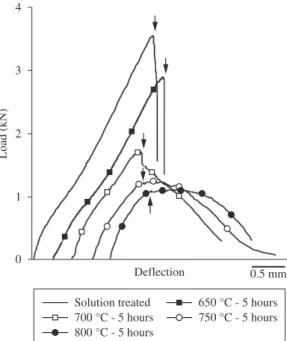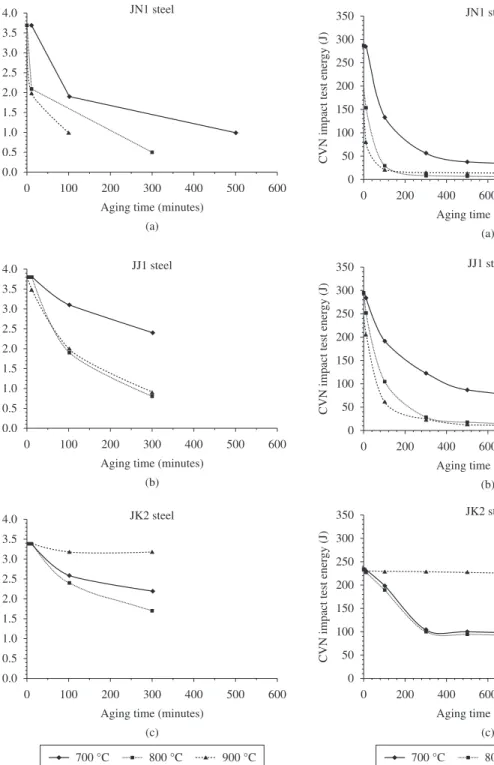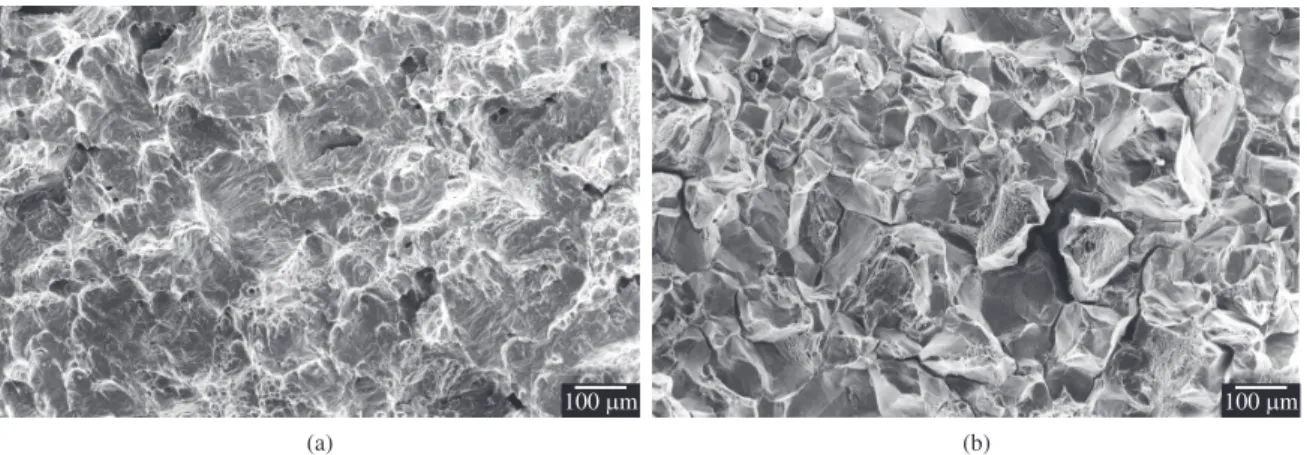*e-mail: vlopezhi@prodigy.net.mx
Correlation between Small Punch and CVN Impact Tests for Evaluation
of Cryogenic Fracture Characteristics of Isothermally-aged
Nitrogen-containing Austenitic Stainless Steels
Maribel Leticia Saucedo-Muñoza, Toshiyuki Hashidab,
Tetsuo Shojib, Victor Manuel Lopez-Hirataa*
aInstituto Politecnico Nacional, CP 07300, Apartado Postal 75-556, México D. F., México bFracture Research Institute,Tohoku University, Aoba-ku, CEP 980-8579, Sendai, Japan
Received: May 11, 2011; Revised: January 15, 2012
The Charpy-V-notch impact test has been used routinely to evaluate the ductile-brittle behavior in steels. Likewise, the Small-Punch test has been applied to evaluate toughness properties in different materials. In this work, both tests were conducted at –196 °C on three types of austenitic stainless steels JN1, JJ1 and JK2, which were solution treated and then aged at temperatures between 700 and 900 °C for 10 and 1000 minutes. The solution treated steels exhibited a ductile fracture with high fracture energy, after testing with both tests. The brittle intergranular fracture was induced by the aging process of specimens and thus the fracture energy of tested specimens decreased dramatically. The highest and lowest decreases in energy with both tests occurred in the aged JN1 and JK2 steels, respectively. The Charpy-v-notch, CVN, test energy and small-punch, SP, test energy at –196 °C was found to follow a linear correlationship equation, CVN Test Energy = 89.7 SP Test Energy –63.0.
Keywords: CVN impact test, SP test, austenitic stainless steels, precipitation
1. Introduction
A high level combination of strength and toughness is required for cryogenic structural materials used in the superconducting magnets of fusion nuclear reactor. This requirement is beyond the capability of conventional austenitic stainless steels1. The Japan Atomic Energy Research Institute (JAERI) developed cryogenic JN1, JJ1 and JK2 austenitic stainless steels1. The structure of superconducting magnets is supposed to be constructed by welding thick plates of this kind of steels. Thus, most of the components are exposed to thermal cycles. The slow cooling may cause microstructure changes in both the base material and the weld zone2. These changes may also decrease the fracture toughness of these materials at cryogenic temperatures. Therefore, it is important to study the effect of thermal aging on fracture toughness behavior for these steels3.
The small-punch (SP) test, using miniaturized specimens, has permitted the evaluation of fracture toughness behavior at different temperatures in different nuclear reactor materials4-7. Furthermore, several studies7,8 have been conducted to establish correlationships between the CVN impact and SP tests. For instance, the ductile-brittle transition temperature was determined by both testing methods and a linear relationship between them was found in low-alloy ferritic steels7.
Thus, the purpose of this work is to evaluate the cryogenic fracture characteristics for three
isothermally-aged nitrogen-containing austenitic stainless steels, JJ1, JN1 and JK2, by means of both the SP and CVN impact testing methods in order to analyze the correlationship between both testing methods.
2. Materials and Experimental Procedure
load-deflection curve was displayed using a computer. The SP test energy of each material was evaluated by measuring the area under the load-deflection curve located between the zero load and the maximum load point where macrocracks initiated. Load-deflection curves were not corrected because of the specimen thickness since thickness was kept constant, 0.5 ± 0.001 mm. The scanning electron microscope (SEM) was used to observe the appearance and fracture surface of tested specimens, as well as the microstructure of steels. The aged samples were prepared metallographically and etched with Vilella´s reagent. The volume fractions of precipitates and brittle-fracture were determined by the point-count grid method10.
The precipitates in aged samples were electrolitically extracted by dissolution of the austenite matrix in a solution composed of 10 vol. %HCl-CH3OH at 4 V (D.C.). The extracted residues were analyzed with an X-ray diffractometer using copper Kα radiation.
3. Results and Discussion
3.1.
Precipitation behavior
Figures 1a-c show, for instance, the microstructure corresponding to the JN1, JJ1 and JK2 steels aged at 800 °C for 300 minutes. The intergranular precipitation can be observed in all cases. The highest and lowest volume fraction of intergranular precipitates corresponded to the aged JN1 and JK2 steels, respectively, Figures 1a-c. The presence of the intergranular cellular precipitation of Cr2N was only observed in the JN1 steel sample aged at 900 °C. No intergranular precipitation was practically found for JK2 steel aged at 700 and 900 °C. Some small transgranular precipitates were present in the aged JN1 and JJ1 steels aged at 700 and 800 °C for 300 minutes, see for example Figures 1a,b. The volume fraction of transgranular precipitates for the aged JJ1 steel was slightly higher than that of the aged JN1 steel. For instance, volume fractions of 0.27 and 0.24 were determined for the JJ1 andJN1 steels,
respectively, aged at 900 °C for 1000 minutes. This tendency became higher by increasing the aging temperature. For example, the volume increased from 0.03 to 0.27 in the JJ1 steel aged at 700 and 900 °C, respectively. Almost no transgranular precipitation was observed in the aged JK2 steel. The precipitation of particles was also observed on twin boundaries for the aged JN1 steel.
The X-ray diffraction patterns of residues extracted from JN1, JJ1 and JK2 steels aged at 800 °C for 300 minutes are shown in Figure 2. As a result of this characterization, Table 1. Chemical composition of JN1, JJ1 and JK2 steels.
Material C Si Mn P S Ni Cr Al N Mo
JN1 0.040 0.97 3.88 0.022 0.001 15.07 24.32 0.023 0.32 –
JJ1 0.025 0.48 10.13 0.021 0.002 11.79 12.01 – 0.236 4.94
JK2 0.05 0.39 21.27 0.005 0.001 9.15 12.97 – 0.247 0.97
Figure 1. SEM micrographs of a) JN1; b) JJ1; and c) JK2 steels aged at 800 °C for 300 minutes.
Figure 3. Load-deflection curves obtained from SP tests at –196 °C for JN1steel.
Figure 4. SEM photographs of tested SP test specimen for the JN1 steel a) solution treated; and b) aged at 800 °C for 300 minutes. In contrast, Cr23C6 was the only phase found in the aged JK2 steel.
According to the chemical composition, shown in Table 1, JN1 steel has the highest and lowest contents of interstitial solutes (C and N), and Mn, respectively. This suggests that the highest volume fraction of precipitation for carbides and nitrides must have occurred in this steel. In contrast, the JK2 steel has a lower interstitial solute content than the JN1 steel; nevertheless, it is only expected the precipitation of carbides for this steel because of the high content of manganese, which avoids its precipitation3.
3.2.
Cryogenic small punch test
Figure 3 shows, for instance, the load-deflection curves for the SP test at –196 °C for the solution treated and the aged JN1 steels. The load increased, as a function of deflection until the maximum load was reached, shown by an arrow (↓) for each curve. After reaching this maximum, either the load dropped drastically or there was a change in the curve slope. This type of behavior was observed in all tested steels. The maximum load and deflection, at maximum load, decreased with the aging temperature for the three tested materials. This decreasing tendency changed in each tested steels. It was also observed that the crack propagation occurred at the maximum value of load during the SP test.
SEM analysis of the tested SP specimens was carried out to determine the fracture appearance of the specimen and
Figure 5. SEM fractographs of tested SP test specimen for the JN1 steel a) solution treated; and b) aged at 800 °C for 300 minutes. Cr23C6 and Cr2N were identified in the JN1 steel. Whereas,
Figure 6. Plot of SP test energy at –196 °C as a function of aging time for a) JN1; b) JJ1; and c) JK2 steels aged at 700, 800 and 900 °C.
Figure 7. CVN test energy at –196 °C as a function of aging time for a) JN1; b) JJ1; and c) JK2 steels aged at 700, 800 and 900 °C.
fracture mode. An SEM micrograph of an SP test specimen of the solution treated JN1 steel is shown in Figure 4a. A semispherical cup and circumferential crack propagation are observed. Fracture dimples were also noticed in the fracture surface of this specimen, Figure 5a. Similar results were also observed for the solution treated JJ1 and JK2 steels. Figures 4b and 5b show, for example, the fracture appearance and fractography of the JN1 steel SP test specimen aged at 800 °C for 300 minutes, respectively. Here, it can be noted
that the crack propagation occurred radially with almost no formation of a cup. The fracture mode is composed of both dimples and intergranular brittle fracture (Figure 8). The same results were observed for the aged JJ1 and JK2 steel specimens.
Figure 8. SEM fractographs of tested CVN test specimen for the JN1 steel a) solution treated; and b) aged at 800 °C for 300 minutes.
decreases in energy correspond to the aged JN1 and JK2 steels, respectively. Besides, it was observed that the lowest decrease in energy with the aging time was present in the JK2 steel aged at 900 °C. Finally, it can be summarized that the evaluation of the fracture toughness in this type of steels by the SP test enabled to follow its toughness deterioration because of the intergranular precipitation during the aging process.
3.3.
Cryogenic CVN impact test
In contrast, Figures 7a-c show the plots of CVN test energy at –196 °C versus aging time for the JN1, JJ1 and JK2 steels, respectively, aged at 700, 800 and 900 °C. All the steels showed a monotonotic decrease in the CVN fracture energy with the aging time at the three temperatures. It is also evident that the drop of fracture toughness of JN1 steel is always faster than that of JJ1 steel. The fastest drop of fracture toughness occurred in the JN1 samples aged at 900 °C. This fact may be attributed to the higher content of C and N in JN1 steel, which can lead to faster kinetics in intergranular precipitation during the aging process, as discussed in a later section. The CVN fracture energy of solution treated JK2 steel was lower than those corresponding to the other two steels. The lowest decrease in the CVN fracture energy was for the aged JK2 steel. Furthermore, the JK2 steel, aged at 900 °C, showed almost no change in the fracture energy with time. The above results are in agreement with those observed by the SP testing method.
All the JN1, JJ1 and JK2 steels fractured in a ductile manner in the solution treated condition, see for instance Figure 7a. In contrast, the intergranular facets, Figure 7b, were found in all the aged samples, although the area fraction of intergranular facets to ductile surface was strongly dependent on the aging conditions. The fraction of intergranular brittle fracture increased with the aging time and temperature, from 0 to 0.9, and it seemed consistent with the CVN fracture energy value. Nevertheless, the fracture surface of the JK2 steel, aged at 900 °C, showed almost a complete ductile- fracture mode. These results are in agreement with the fracture mode observed in the SP tested specimens.
The highest and lowest degradation in toughness for JN1 and JK2 steel, respectively, is associated with the volume fraction of intergranular precipitation formed during the thermal aging. An abundant presence of intergranular precipitates causes the reduction of cohesive strength of grain boundaries11. This is also confirmed by the increase in the intergranular brittle fracture as the thermal aging progresses. The critical decrease in energy started after reaching a volume fraction of precipitates of about 0.1 in the aged steels.
3.4.
SP and CVN tests relationship
4. Conclusions
A study of the evaluation of susceptibility to the thermal-aging embrittlement was carried out by means of the SP test for the aged JN1, JJ1 and JK2 steels and the conclusions are:
1) A linear correlationship between the CVN test energy and the SP test energy at 196 °C was determined to be as follows (Equation 2):
ECVN = 89.7 ESP – 63.0 (2)
2) Both testing method enabled to follow the aging-induced embrittlement with the same fracture characteristics.
3) The aging-induced embrittlement was more severe in the aged steel with volume fractions of precipitates higher than 0.1.
Acknowledgements
The authors, MLSM and VMLH, wish to thank the financial support from SIP-COFAA-IPN and CONACYT.
References
1. Nakajima H, Yoshida K and Shimamoto K. Development of new cryogenic steels for the superconducting magnets of the fusion experimental reactor. ISIJ International. 1990; 30:567-578. http://dx.doi.org/10.2355/isijinternational.30.567
2. Kwon I, Liu S, Saucedo M, Hashida T and Takahashi H. A study of the cryogenic fracture behavior of superconducting magnets structural material by means of the SP testing method. Transactions of the Japan Society of Mechanical Engineers. 1997; 63:61-67. http://dx.doi.org/10.1299/ kikaia.63.61
3. Saucedo-Muñoz M, Hashida T, Watanabe Y, Shoji T and Lopez-Hirata V. Effect of precipitation on cryogenic toughness in N-containing austenitic stainless Steels. Materials Science Forum. 2007; 539-543:4914-4919. http://dx.doi.org/10.4028/ www.scientific.net/MSF.539-543.4914
4. Baik JM, Kameda J and Buck O. Small punch test evaluation of intergranular embrittlement of an alloy steel. Scripta Metallurgica et Materialia. 1983; 17:1443-1447.
5. Misawa T, Nagata S, Aoki N, Ishizaka J and Hamaguchi Y. Fracture toughness evaluation of fusion reactor structural steels at low temperatures by small punch tests. Journal of Nuclear Materials. 1989; 169:225-232. http://dx.doi.org/10.1016/0022-3115(89)90538-2
6. Saucedo-Muñoz M, Liu S, Komazaki S, Kwon I , Hashida T, Takahashi H et al. Evaluation of Thermal Aging Embrittlement of
austenitic stainless steels JN1, JJ1 and JK2 by Cryogenic Small-Punch Testing. Journal of Materials Research. 2002; 17:852-858. http://dx.doi.org/10.1557/JMR.2002.0124
7. Bulloch JC. A study concerning material fracture toughness and some small punch test data for low alloy steels. Engineering Failure Analysis. 2004; 11:635-653. http://dx.doi.org/10.1016/j. engfailanal.2003.05.020
8. Saucedo-Muñoz M, Matsushita H, Hashida Shoji T and Takahashi H. Development of a MLR model to estimate the ductile-brittle transition temperature of ferritic low-alloy steels based on the relationship between SP and CVN Tests. Journal of Testing and Evaluation. 2000; 28:352-358. http://dx.doi. org/10.1520/JTE12162J
9. Japanese Industrial Standards - JIS. JIS Z-2242 8: Method of impact test for metallic materials. Tokyo: JIS Handbook; 1997.
10. American Society for Metals - ASM. Metals Handbook. Ohio: ASM; 1990. v. 8.
11. Muster WJ and Elster J. Low temperature embrittlement after ageing stainless steels. Cryogenics. 1990; 30:799-802. http:// dx.doi.org/10.1016/0011-2275(90)90278-K
12. Cuesta II, Alegre JM and Lacalle R. Determination of the Gurson-Tevergaard damage model parameters for simulating small punch tests. Fatigue and Fracture of Engineering Materials and Structures. 2010; 33:703-713.
in Figure 9. This figure also shows the dispersion curve for ±10% in the slope value. This data dispersion can be related to the different chemical composition of tested steels and volume fraction of precipitates originated at different aging temperatures. Nevertheless, this type of linear relation may be used to estimate the CVN test energy by means of the SP tests in small areas, such as heat affected zones. The regression equation for this linear relation was (Equation 1):
ECVN = 89.7 ESP – 63.0 (1)



